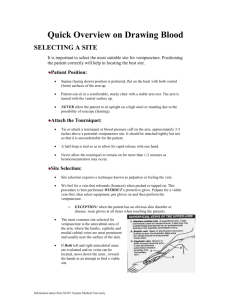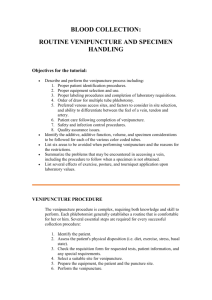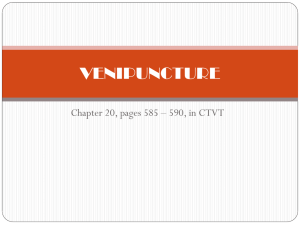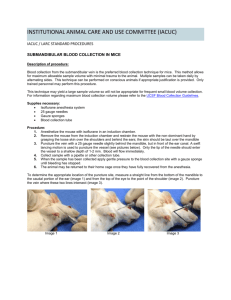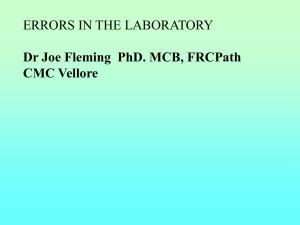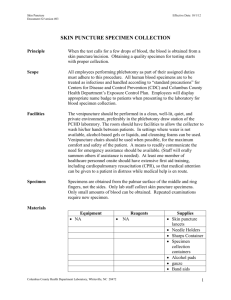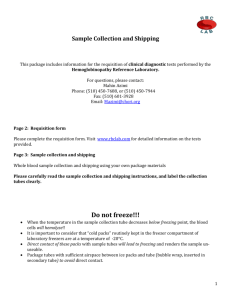Chapter 17 Phlebotomy 17- Instructor`s Resource Manual Key Term
advertisement
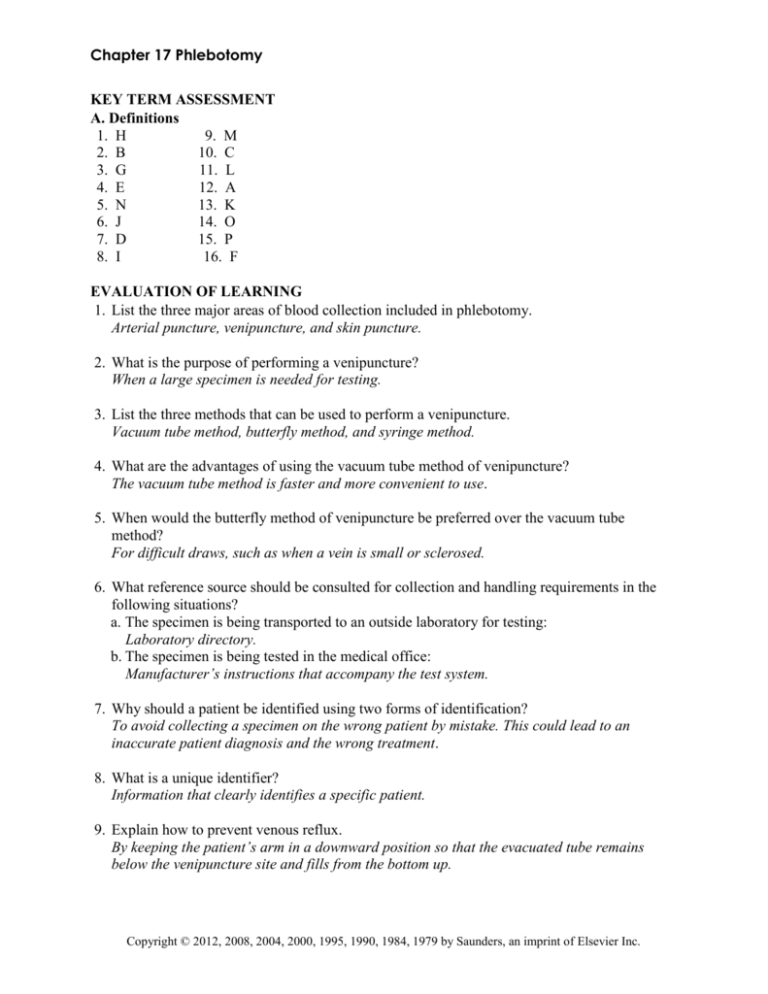
Chapter 17 Phlebotomy KEY TERM ASSESSMENT A. Definitions 1. H 9. M 2. B 10. C 3. G 11. L 4. E 12. A 5. N 13. K 6. J 14. O 7. D 15. P 8. I 16. F EVALUATION OF LEARNING 1. List the three major areas of blood collection included in phlebotomy. Arterial puncture, venipuncture, and skin puncture. 2. What is the purpose of performing a venipuncture? When a large specimen is needed for testing. 3. List the three methods that can be used to perform a venipuncture. Vacuum tube method, butterfly method, and syringe method. 4. What are the advantages of using the vacuum tube method of venipuncture? The vacuum tube method is faster and more convenient to use. 5. When would the butterfly method of venipuncture be preferred over the vacuum tube method? For difficult draws, such as when a vein is small or sclerosed. 6. What reference source should be consulted for collection and handling requirements in the following situations? a. The specimen is being transported to an outside laboratory for testing: Laboratory directory. b. The specimen is being tested in the medical office: Manufacturer’s instructions that accompany the test system. 7. Why should a patient be identified using two forms of identification? To avoid collecting a specimen on the wrong patient by mistake. This could lead to an inaccurate patient diagnosis and the wrong treatment. 8. What is a unique identifier? Information that clearly identifies a specific patient. 9. Explain how to prevent venous reflux. By keeping the patient’s arm in a downward position so that the evacuated tube remains below the venipuncture site and fills from the bottom up. Copyright © 2012, 2008, 2004, 2000, 1995, 1990, 1984, 1979 by Saunders, an imprint of Elsevier Inc. Instructor’s Resource Manual 17-2 10. What is the purpose of the tourniquet? To make the patient’s veins stand out so that they are easier to palpate. 11. Why are the antecubital veins preferred for performing a venipuncture? These veins have a wide lumen and are easily accessible and close to the surface of the skin. They also have thick walls, making them less likely to collapse. 12. After locating a suitable vein for venipuncture, what three qualities should be determined with respect to the vein? Size, depth, and direction of the vein. 13. List four techniques that can be used to make veins more prominent. Remove the tourniquet and have the patient dangle the arm over the side of the chair for 1 or 2 minutes. Tap at the vein sharply a few times. Gently massage the arm from the wrist to the elbow. Apply a warm, moist washcloth to the area for 5 minutes. 14. Why should the veins of the hand be used only as a last resort when performing a venipuncture? The veins of the hands have a tendency to roll, making them more difficult to stick. There is an abundant supply of nerves in the hand, which makes this procedure more uncomfortable for the patient. Hand veins have thin walls, making them more susceptible to collapsing and bruising and phlebitis. 15. How is a serum specimen obtained? From clotted blood by allowing the specimen to stand and then centrifuging it. 16. How is a whole blood specimen obtained? By using a tube containing an anticoagulant to prevent clotting. 17. List the three layers into which blood separates when it is mixed with an anticoagulant. A top layer of plasma, a middle layer of white blood cells and platelets (buffy coat), and a bottom layer of red blood cells. 18. List the layers into which blood separates when an anticoagulant is not added to it. A top layer of serum and a bottom layer of blood cells. 19. List six OSHA safety precautions that must be followed when performing a venipuncture and separating serum or plasma from whole blood. Wear gloves when it is reasonably anticipated that you will have hand contact with blood. Avoid hand-to-mouth contact while working with blood specimens. Face shields or masks in combination with eye protection devices must be worn whenever splashes, spray, spatter, or droplets of blood may be generated. Perform all procedures involving blood in a manner so as to minimize splashing, spraying, spattering, and generation of droplets of these substances. Copyright © 2012, 2008, 2004, 2000, 1995, 1990, 1984, 1979 by Saunders, an imprint of Elsevier Inc. Instructor’s Resource Manual 17-3 Bandage cuts and other lesions on the hands before gloving. Sanitize hands as soon as possible after removing gloves. If your hands or other skin surfaces come in contact with blood, wash the area as soon as possible with soap and water. If your mucous membranes come in contact with blood, flush them with water as soon as possible. Do not bend, break, or shear contaminated venipuncture needles. Do not recap a contaminated venipuncture needle. Locate the sharps container as close as possible to the area of use. Immediately after use, place the contaminated venipuncture needle in a biohazard sharps container. Handle all laboratory equipment and supplies properly and with care as indicated by the manufacturer. Do not store food in refrigerators where testing supplies or specimens are stored. If you are exposed to blood, report the incident immediately to your physician and employer. 20. What is the range for the gauge and length of the needle used for the vacuum tube method of venipuncture? Gauge: 20 to 22; needle length: 1 and 11⁄2 inches. 21. What is the purpose of the flange on the plastic holder of the vacuum tube system? To assist in the insertion and removal of evacuated tubes and to prevent the holder from rolling on a flat surface. 22. What type of additive is present in each of the following evacuated tubes? Red No additive is present. Red/gray speckled Clot activator. Lavender EDTA. Light blue Sodium citrate. Green Heparin. Gray Sodium fluoride and potassium oxalate. Royal blue Either EDTA or no additive at all. 23. What color stopper must be used to collect the blood specimen for each of the tests listed? Complete blood count Lavender. Prothrombin time Light blue. Glucose tolerance test Gray. Most blood chemistry tests Red. Blood gas determinations Green. Lead testing Royal blue. 24. Why is it important to use the correct order of draw when performing a venipuncture? To prevent contamination of nonadditive tubes by additive tubes and cross-contamination between different types of additives that could lead to inaccurate test results. 25. Why is it important to mix a tube containing an anticoagulant immediately after drawing it? Copyright © 2012, 2008, 2004, 2000, 1995, 1990, 1984, 1979 by Saunders, an imprint of Elsevier Inc. Instructor’s Resource Manual 17-4 To prevent the blood from clotting, leading to inaccurate test results. 26. What is the range for the gauge and length of needle used for the butterfly method of venipuncture? Gauge: 21 to 23; needle length: 1/2 to 3/4 inch. 27. How can a vein be prevented from rolling when performing a venipuncture on the cephalic or basilic veins? By applying firm pressure below and to the side of the vein to stabilize it as the needle is inserted. 28. What is typically observed when performing a venipuncture on a vein that collapses? A small amount of blood enters the tube and then stops. 29. What are three ways in which a hematoma may occur? A needle that is inserted too far and that goes through the vein, a bevel opening that is partially in the vein and partially out of the vein, and insufficient pressure applied to the puncture site after removing the needle. 30. List four ways to prevent a blood specimen from becoming hemolyzed. Store the vacuum tubes at room temperature. Allow the alcohol to air dry completely before performing the venipuncture. Do not use a small-gauge needle to collect the specimen. Practice good technique in collecting the specimen. Always handle the blood specimen carefully. 31. List examples of substances dissolved in the serum of blood. Glucose, cholesterol, sodium, potassium, chloride, antibodies, hormones, and enzymes. 32. What is the purpose of performing laboratory tests on serum? To determine whether the dissolved substances in the serum are within normal limits and to detect the presence of any substance that should not normally be present in the serum. 33. List the proper size tube that must be used to obtain the following serum specimens. 2 ml of serum 5 ml. 6 ml of serum 15 ml. 4 ml of serum 10 ml. 34. What is a fibrin clot and why should it be avoided in a serum specimen? A fibrin clot is a spongelike substance that occupies space and interferes with adequate serum collection. 35. How does a serum separator tube function in the collection of a serum specimen? A serum separator tube contains a gel that temporarily becomes fluid during centrifugation and moves to the dividing point between the serum and cells. It reforms into a solid gel that serves as a physical and chemical barrier between the serum and clot. Copyright © 2012, 2008, 2004, 2000, 1995, 1990, 1984, 1979 by Saunders, an imprint of Elsevier Inc. Instructor’s Resource Manual 17-5 36. List four types of solutes contained in the plasma. Plasma proteins, electrolytes, nutrients, waste products, and respiratory gases. 37. What is the preferred site for a skin puncture for the following individuals? a. Adult Fingertip of the third or fourth finger. b. Infant Plantar surface of the heel. 38. Why is it important not to penetrate the skin too deeply when performing a skin puncture? To prevent osteochondritis or osteomyelitis. 39. How does the medical assistant determine the blade length to use to perform a skin puncture? Blade length is based on the size of the patient’s fingers and the amount of blood specimen required. 40. What are two examples of microcollection devices? Capillary tubes and microcollection tubes. 41. Why should a finger puncture not be performed on the index finger? The index finger is calloused and harder to penetrate; the patient uses the index finger more frequently and would notice the pain longer. 42. Why should the first drop of blood be wiped away when performing a finger puncture? The first drop of blood is diluted with alcohol and tissue fluid, which may lead to inaccurate test results. CRITICAL THINKING ACTIVITIES A. Antecubital Veins Practice palpating the antecubital veins on at least five classmates. Use a tourniquet applied to each person’s arm, and ask the individual to clench his or her fist. Record the individual’s name and which vein would be considered the best to use on each person when performing venipuncture. B. Venipuncture—Vacuum Tube Method Using the principles outlined in the vacuum tube venipuncture procedure, state what can happen under the following circumstances: 1. An evacuated tube is used that is past its expiration date. The tube may no longer have a vacuum. 2. The vacuum tube is not labeled. This may result in a mix-up of specimens. 3. The tourniquet is not applied tightly enough. The vein does not stand out to be palpated. 4. The tourniquet is left on for more than 1 minute. It is uncomfortable for the patient and may alter the test results. 5. The area that has just been cleansed with an antiseptic is not allowed to dry before the venipuncture is made. Alcohol entering the blood specimen contaminates it, leading to inaccurate test results. The alcohol causes the patient to experience a stinging sensation. 6. The evacuated tube is inserted past the indentation in the plastic holder before the vein is Copyright © 2012, 2008, 2004, 2000, 1995, 1990, 1984, 1979 by Saunders, an imprint of Elsevier Inc. Instructor’s Resource Manual 17-6 entered. The tube fills with air and does not produce a blood specimen. 7. An angle of less than 15 degrees is used when performing venipuncture. The needle may enter above the vein, preventing puncture. 8. An angle of more than 15 degrees is used when performing venipuncture. The needle may go through the vein by puncturing the posterior wall. 9. The needle is moved after inserting it. This causes patient discomfort. 10. Venous reflux occurs when using an EDTA evacuated tube. Venous reflux could cause the patient to have an adverse reaction to the tube additive. 11. The vacuum tube is removed before it has filled to the exhaustion of the vacuum. This causes a rush of air to enter the tube, damaging red blood cells. 12. The needle is removed from the arm before the tourniquet has been removed. Pressure on the vein from the tourniquet causes internal and external bleeding around the puncture site. 13. A gauze pad is not placed slightly above the puncture site before removing the needle. Tissue movement may occur as the needle is withdrawn, resulting in patient discomfort. 14. The patient bends the arm at the elbow after the needle is removed. This increases loss of blood from the puncture site. 15. The patient lifts a heavy object after the procedure. This causes pressure on the puncture site that could result in bleeding. C. Venipuncture Situations You are responsible for performing the venipunctures in your medical office. In the space provided, explain what you would do in each of the following situations: 1. The patient asks you if the venipuncture will hurt. Tell the patient that a small amount of pain is associated with the venipuncture, but it is of short duration. 2. On palpating the patient’s vein, you find that it feels stiff and hard. If possible, another vein should be used. If this is impossible, the needle should be inserted with careful pressure to avoid going completely through the vein. 3. You have attempted one venipuncture in a patient with small veins using the vacuum tube method of venipuncture; however, the vein collapsed, and you were unable to obtain blood. Try again at a different site using the butterfly method. 4. The patient moves during the procedure, causing the needle to come out of his arm. Remove the tourniquet immediately, and place a gauze pad on the puncture site and apply pressure. 5. You have inserted the needle in the vein, but notice a sudden swelling around the puncture site. Remove the tourniquet and needle immediately, and, using a gauze pad, apply pressure to the puncture site. 6. You inadvertently puncture the brachial artery after inserting the needle. The tourniquet should be removed and then the needle. Pressure with a gauze pad should be applied for 4 to 5 minutes. 7. The patient begins to sweat and tells you that he or she feels warm and light-headed. The patient should be placed in a position that promotes blood flow to the brain. D. Separating Serum Explain why the following guidelines must be observed while separating serum from whole blood. 1. Label the transfer tube with the word serum. To avoid confusion and mix-up among specimens 2. Place the tube in an upright position for 30 to 45 minutes. To permit clot formation, which Copyright © 2012, 2008, 2004, 2000, 1995, 1990, 1984, 1979 by Saunders, an imprint of Elsevier Inc. Instructor’s Resource Manual 17-7 yields more serum from the specimen 3. Do not allow the specimen to stand for more than 1 hour before centrifuging it. Changes occur in the specimen that lead to inaccurate test results. 4. Make sure the tube is stoppered during centrifugation. To prevent evaporation of the specimen, which leads to falsely elevated results 5. Wear personal protective equipment when transferring serum from whole blood. To provide protection against bloodborne pathogens 6. Do not disturb the cell layer while pipetting the serum. This may cause red blood cells to enter the serum specimen, and the specimen would need to be recentrifuged. E. Skin Puncture The medical assistant is performing a skin puncture on an adult patient to obtain a capillary blood specimen for a hemoglobin test. For each of the following situations, write C if the technique is correct and I if the technique is incorrect. If the technique is correct, explain the rationale for performing it that way; if incorrect, explain what might happen if the technique were performed in the incorrect manner. 1. Before making the puncture, the medical assistant asks the patient to rinse his hand in warm water. C: Warming the site increases blood flow to the capillary bed. 2. The puncture is made with the patient in a standing position. I: The patient could faint and injure himself or herself. 3. The site is allowed to dry thoroughly after it is cleansed with an antiseptic wipe. C: Permitting the site to dry allows a round drop of blood to form, making it easier to collect the specimen; alcohol may cause inaccurate test results and causes a stinging sensation to the patient when the puncture is made. 4. The specimen is collected from the lateral part of the tip of the ring finger. C: The capillary bed in these fingers is large, and the skin is easy to penetrate. 5. The puncture is made perpendicular to the lines of the fingerprint. C: This facilitates the formation of a well-formed drop of blood that is easy to collect. 6. The depth of the puncture is 4 mm. I: A puncture deeper than 3.1 mm may cause the lancet to penetrate bone. 7. The first drop of blood is wiped away. C: The first drop of blood is diluted with alcohol and tissue fluid. 8. The puncture site is squeezed to obtain the blood specimen. I: Excessive squeezing can cause dilution of the blood specimens with tissue fluids. APPLY YOUR KNOWLEDGE Choose the best answer to each of the following questions. 1. Hugh Everett comes to the medical office to have his blood drawn for an FBS and CBC. Dori Glover, CMA (AAMA), prepares for the venipuncture. What should Dori do first? A. Get out her rabbit’s foot and hope for a good vein B. Label the evacuated tube, and complete a laboratory requisition C. Cleanse the puncture site thoroughly with an antiseptic wipe D. Ask Hugh when he last ate or drank 2. Dori is getting ready to apply the rubber tourniquet to Hugh’s arm. All of the following are correct techniques for Dori to use when applying the tourniquet except Copyright © 2012, 2008, 2004, 2000, 1995, 1990, 1984, 1979 by Saunders, an imprint of Elsevier Inc. Instructor’s Resource Manual 17-8 A. Applying the tourniquet 3 inches above the bend in the elbow B. Applying the tourniquet loosely so that it is not uncomfortable for Hugh C. Asking Hugh to clench his fist to make the antecubital veins more prominent D. Making sure not to leave the tourniquet on for more than 1 minute 3. After applying the tourniquet to Hugh’s arm, Dori determines that the median cubital vein on his left arm would be the best vein to use. Dori performs an assessment of the vein by A. Palpating the size and depth of the vein B. Tracing the path of the vein C. Mentally mapping the location of the vein on Hugh’s arm D. All of the above 4. Dori is getting ready to draw blood from Hugh using the vacuum tube method of venipuncture. Which of the following is not a correct technique for Dori to use when inserting the needle? A. Inserting the needle with the bevel facing up B. Pointing the needle in the same direction as the vein to be entered C. Inserting the needle at a 45-degree angle to the arm D. Positioning the evacuated tube with the label facing downward 5. After filling the lavender stoppered evacuated tube to the exhaustion of the vacuum and removing it from the plastic holder, Dori proceeds to the next step of the procedure, which is to A. Gently invert the tube back and forth eight times B. Remove the needle from the vein C. Break into song for performing a successful stick D. Apply pressure to the puncture site with a gauze pad 6. Amy Anderson has come to the medical office to have her blood drawn as part of a college sports physical requirement. Which of the following is a good question for Dori Glover, CMA (AAMA), to ask Amy to facilitate this procedure? A. What kind of sports are you involved in? B. Who is your next of kin? C. What vein has been used in the past to draw your blood? D. Are you allergic to any medications? 7. Dori examines the veins of both of Amy’s arms and cannot palpate a median cubital vein. Dori is able to palpate a large cephalic vein in the antecubital space of Amy’s left arm and decides to draw the blood specimen from that vein. Of the following, which is an important step to perform when drawing blood from Amy’s cephalic vein? A. Applying the tourniquet as tightly as possible B. Applying firm pressure below and to the side of the vein C. Using a small-gauge needle to collect the specimen D. Using a Hemogard tube to collect the specimen Copyright © 2012, 2008, 2004, 2000, 1995, 1990, 1984, 1979 by Saunders, an imprint of Elsevier Inc. Instructor’s Resource Manual 17-9 8. Dori successfully collects a blood specimen from Amy. All of the following are correct techniques for Dori to use when withdrawing the needle except A. Removing the tourniquet before withdrawing the needle B. Removing the needle at the same angle as that for penetration C. Asking Amy to keep her fist clenched as the needle is withdrawn D. Applying pressure to the puncture site after withdrawing the needle 9. Dr. Hemolysis asks Dori Glover, CMA (AAMA), to collect a capillary blood specimen from Ashley Mackenzie, age 6 months, to check her hemoglobin level. What is an appropriate puncture site for Dori to use? A. Plantar surface of the heel B. Tip of the thumb C. Earlobe D. Lateral side of the third fingertip 10. Dori uses a disposable retractable lancet to collect the blood specimen from Ashley. After making the puncture, Dori should A. Squeeze the puncture site to increase the blood flow B. Wipe away the first drop of blood C. Collect the blood specimen D. Warm the site to increase the blood flow VIDEO EVALUATION: CHAPTER 17: PHLEBOTOMY Directions: a. Watch the indicated videos. b. Mark each true statement with a T and each false statement with an F. For each false statement, change the wording of the question so that it becomes a true statement. Video: Procedure 17-1: Venipuncture—Vacuum Tube Method ____T___1. Venipuncture is performed when a large blood specimen is needed for laboratory testing. ____T___2. The vacuum tube method is the fastest and most convenient venipuncture method. ____F___3. Identify the patient by asking the patient to state his or her last name and social security number. ____F___4. The patient should be asked if she has prepared properly after performing the venipuncture. ____F___5. A 25-gauge needle should be used to perform a venipuncture. ____F___6. A red-stoppered tube should be used to collect a specimen for a CBC. ____T___7. Outdated evacuated tubes may no longer have a vacuum. ____F___8. A lavender-stoppered tube should be drawn before a serum separator tube. ____T___9. The tourniquet should be applied 3 to 4 inches above the bend in the elbow. ____F___10. The tourniquet should be applied as tightly as possible. ____T___11. The tourniquet should never be left on for more than 1 minute at a time. ____T___12. The alcohol should be allowed to dry at the puncture site to provide enough time for it to destroy microorganisms on the skin. Copyright © 2012, 2008, 2004, 2000, 1995, 1990, 1984, 1979 by Saunders, an imprint of Elsevier Inc. Instructor’s Resource Manual 17-10 The needle should be positioned at a 30-degree angle to the patient’s skin. As the vein is entered, a sensation of resistance is felt followed by a “release.” The evacuated tube should be filled to the exhaustion of the vacuum. The flange should be used to remove the evacuated tube from the holder. If the tube contains an anticoagulant, it should be vigorously shaken 8 to 10 times. The needle should be withdrawn at the same angle as that for penetration. The SST should be allowed to stand in an upright position for 10 to 15 minutes before centrifuging it. ____T___20. The blood tubes should be placed in a biohazard specimen bag for transport to an outside laboratory. ____F___13. ____T___14. ____T___15. ____T___16. ____F___17. ____T___18. ____F___19. Video: Procedure 17-2: Venipuncture—Butterfly Method ____T___ 1. The butterfly method of venipuncture is also known as the winged infusion method. ____T___ 2. The butterfly method is used for small or sclerosed veins. ____F___ 3. The gauge of the needle for the butterfly method ranges between 18 and 20. ____T___ 4. The tubing of the butterfly setup should be stretched slightly to permit a free flow of blood in the tubing. ____F___ 5. The vein selected for the venipuncture should be thoroughly palpated with the thumb. ____T___ 6. The puncture site should be cleansed using a circular motion. ____T___ 7. If the alcohol is not permitted to dry, the patient may experience a stinging sensation when the needle is inserted. ____T___8. The needle should be positioned so that it points in the same direction as the vein to be entered. ____T___9. If the butterfly needle is in the vein, a flash of blood will appear at the top of the tubing. ____T___10. Seating the needle lets you use both hands for changing tubes. ____F___11. The evacuated tube should be allowed to fill from the top downward. ____F___12. If the tube is removed before the vacuum is exhausted, the patient will get a hematoma. ____T___13. The tube should be gently inverted 5 times if it contains a clot activator. ____F___14. The needle should be removed before removing the tourniquet. ____F___15. The patient should be instructed to bend the arm at the elbow after the needle is removed. Video: Procedures 17-5 and 17-6: Obtaining a Capillary Blood Specimen ____F___ 1. The index or little finger should be used when performing a finger puncture. ____T___ 2. If the alcohol is not allowed to dry, the blood may leach out and run down the finger. ____F___ 3. Wet alcohol should be wiped off the puncture site with a gauze pad. ____T___ 4. The puncture should be made in the center of the fingertip. ____T___ 5. Moving the lancet too soon after making the puncture can lead to an inadequate puncture and poor blood flow. ____F___ 6. The first drop of blood should be wiped away with an antiseptic wipe. ____T___ 7. Squeezing or massaging the puncture site excessively causes dilution of the blood sample with tissue fluid leading to inaccurate test results. Copyright © 2012, 2008, 2004, 2000, 1995, 1990, 1984, 1979 by Saunders, an imprint of Elsevier Inc.
